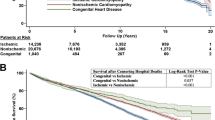Abstract
Background
One reason for refusal of donor hearts is the development of left ventricular systolic dysfunction, a condition reported to occur in up to 42 % of adults with brain death. Prior studies have suggested that appropriate donor management and evaluation of cardiac dysfunction with serial echocardiography (TTE) can improve organ procurement. The aims of our study are to examine the prevalence and describe longitudinal changes in cardiac dysfunction after brain death.
Methods
A cross-sectional study was performed using the Life Center Northwest organ database to identify potential adult heart donors diagnosed with brain death between January 2011 and November 2013. 246 potential donors with at least one TTE following brain death were identified. 58 donors received serial TTEs. Echocardiograms were reviewed for cardiac dysfunction, defined as left ventricular ejection fraction (EF) <50 % and/or presence of regional wall motion abnormalities.
Results
Cardiac dysfunction was present in 74 (30 %) patients. Age, body mass index, EF, and proportion of harvested organs differed significantly between the groups with and without cardiac dysfunction. Among patients receiving serial TTEs, 29 patients had cardiac dysfunction on initial TTE, with 15 (52 %) of these patients demonstrating resolved cardiac dysfunction over time leading to organ harvest.
Conclusions
To our knowledge, the present study is the largest study describing the use of serial TTE and its utilization in adult donors. The prevalence of cardiac dysfunction after adult brain death is high, but given enough time and support, many of these donors have improvement in cardiac function, ultimately leading to transplantation.

Similar content being viewed by others
References
Organ Procurement and Transplantation Network (OPTN) and Scientific Registry of Transplant Recipients (SRTR). OPTN/SRTR 2012 Annual Data Report. 2012. Accessed 12.7.2014 http://www.unos.org/docs/AnnualReport2012.pdf.
Zaroff JG, Babcock WD, Shiboski SC. The impact of left ventricular dysfunction on cardiac donor transplant rates. J Heart Lung Trans. 2003;22:334–7.
Zaroff JG, Rosengard BR, Armstrong WF, et al. Consensus conference report: maximizing use of organs recovered from the cadaver donor: cardiac recommendations, March 28–29, 2001, Crystal City. Va. Circ. 2002;106:836–41.
Wood KE, Becker BN, McCartney JG, D’Alessandro AM, Coursin DB. Care of the potential organ donor. N Engl J Med. 2004;351:2730–9.
Dujardin KS, McCully RB, Wijdicks EF, et al. Myocardial dysfunction associated with brain death: clinical, echocardiographic, and pathologic features. J Heart Lung Trans. 2001;20:350–7.
Gallardo A, Anguita M, Franco M, et al. The echocardiographic findings in patients with brain death. The implications for their selection as heart transplant donors]. Rev Esp Cardiol. 1994;47:604–8.
Gilbert EM, Krueger SK, Murray JL, et al. Echocardiographic evaluation of potential cardiac transplant donors. J Thorac Cardiovasc Surg. 1988;95:1003–7.
Godino M, Lander M, Cacciatore A, Perez-Protto S, Mizraji R. Ventricular dysfunction associated with brain trauma is cause for exclusion of young heart donors. Trans Proc. 2010;42:1507–9.
Kron IL, Tribble CG, Kern JA, et al. Successful transplantation of marginally acceptable thoracic organs. Ann Surg. 1993;217:518–22; discussion 22-4.
Apostolakis E, Parissis H, Dougenis D. Brain death and donor heart dysfunction: implications in cardiac transplantation. J Card Surg. 2010;25:98–106.
Banki NM, Kopelnik A, Dae MW, et al. Acute neurocardiogenic injury after subarachnoid hemorrhage. Circulation. 2005;112:3314–9.
Todd GL, Baroldi G, Pieper GM, Clayton FC, Eliot RS. Experimental catecholamine-induced myocardial necrosis. I. Morphology, quantification and regional distribution of acute contraction band lesions. J Mol Cell Cardiol. 1985;17:317–38.
Novitzky D. Novel actions of thyroid hormone: the role of triiodothyronine in cardiac transplantation. Thyroid. 1996;6:531–6.
Szabo G, Sebening C, Hackert T, et al. Influence of brain death and cardiac preservation on systolic and diastolic function and coronary circulation in the cross-circulated canine heart. World J Surg. 1999;23:36–43.
Macrea LM, Tramer MR, Walder B. Spontaneous subarachnoid hemorrhage and serious cardiopulmonary dysfunction—a systematic review. Resuscitation. 2005;65:139–48.
Prathep S, Sharma D, Hallman M, et al. Preliminary report on cardiac dysfunction after isolated traumatic brain injury. Crit Care Med. 2014;42:142–7.
Wittstein IS, Thiemann DR, Lima JA, et al. Neurohumoral features of myocardial stunning due to sudden emotional stress. N Engl J Med. 2005;352:539–48.
White M, Wiechmann RJ, Roden RL, et al. Cardiac beta-adrenergic neuroeffector systems in acute myocardial dysfunction related to brain injury. Evidence for catecholamine-mediated myocardial damage. Circulation. 1995;92:2183–9.
Paul JJ, Tani LY, Shaddy RE, Minich LL. Spectrum of left ventricular dysfunction in potential pediatric heart transplant donors. J Heart Lung Trans. 2003;22:548–52.
Lavie CJ, Milani RV, Ventura HO. Obesity and cardiovascular disease: risk factor, paradox, and impact of weight loss. J Am Coll Cardiol. 2009;53:1925–32.
Zaroff JG, Babcock WD, Shiboski SC, Solinger LL, Rosengard BR. Temporal changes in left ventricular systolic function in heart donors: results of serial echocardiography. J Heart Lung Trans. 2003;22:383–8.
Venkateswaran RV, Townend JN, Wilson IC, Mascaro JG, Bonser RS, Steeds RP. Echocardiography in the potential heart donor. Transplantation. 2010;89:894–901.
Brandspiegel HZ, Marinchak RA, Rials SJ, Kowey PR. A broken heart. Circulation. 1998;98:1349.
Chamorro C, Romera MA, Silva JA. Stunned myocardium in brain death. Med Intensiva. 2006;30:299–300.
Venkateswaran RV, Ganesh JS, Thekkudan J, et al. Donor cardiac troponin-I: a biochemical surrogate of heart function. Eur J Cardiothorac Surg. 2009;36:286–92; discussion 92.
Acknowledgement
The authors wish to thank the management and staff of Life Center Northwest for their help and support in gathering clinical records, databases, and materials for our analysis. This study was supported, in part, by an NRSA T32 (T32 GM086270) training grant.
Conflict of interest
Xenia Borbely, Vijay Krishnamoorthy, Shan Modi, Ali Rowhani-Rahbar, Edward Gibbons, and Monica Vavilala declare that they have no conflict of interest. Michael Souter is receiving 10 % institutional salary support through Life Center Northwest.
Author information
Authors and Affiliations
Corresponding author
Rights and permissions
About this article
Cite this article
Borbely, X.I., Krishnamoorthy, V., Modi, S. et al. Temporal Changes in Left Ventricular Systolic Function and Use of Echocardiography in Adult Heart Donors. Neurocrit Care 23, 66–71 (2015). https://doi.org/10.1007/s12028-014-0101-x
Published:
Issue Date:
DOI: https://doi.org/10.1007/s12028-014-0101-x




